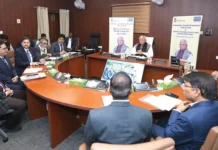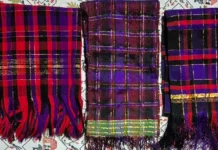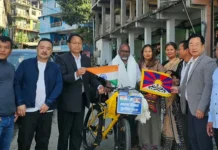Homage from a tribal
[ Dr Razzeko Dele ]
Ramchandra Guha in his famous book ‘Makers of Modern India’ considers Verrier Elwin as the defender of Indian tribals.
To quote the book, “Gandhi paid close attention to the problems of women, Muslims and untouchables. However, despite being some eight percent of India’s population, the tribals had been ignored by the national movement. Other political thinkers and activists also did not focus on them.
Once, when charged with the question of why he didn’t take up tribal questions, BR Ambedkar answered: “I have never claimed to be a universal leader of suffering humanity. The problem of untouchables is quite enough for my suffering strength.”
This was reasonable, but it still left a large and vulnerable section unrepresented in public discourse. This was the gap that Verrier Elwin sought to fill.
Through the 1940s, Elwin published a series of major books on individual tribes. He also wrote many articles in newspapers and magazines on policy matters. The range and sheer bulk of his work was matched by a manifest sympathy with his subject, with the findings of his research communicated with a grace uncharacteristic of academic writing’.
Then Home Minister of India, Govind Ballabh Pant was of similar view-”The great achievement of Dr Elwin in the last 20 years has been to make people all over India regard the tribals with respect. Previously we had looked on them as savages. But he has shown us that they have culture and arts of their own.’
Verrier Elwin (29 August 1902 – 22 February 1964) was born to a colonial bishop, and was reared in a fiercely evangelical family. Educated and doctorate from Oxford, he came to India in 1927 as a missionary. In India, he became a disciple of Gandhi and abandoned his missionary work. Subsequently, Elwin was de-licensed by the Church of England in 1936 for his refusal to take the Gospel to the tribes.
During his days in Gandhi’s ashram, Elwin came in touch with Sardar Vallabhai Patel. It was Patel who advised Elwin to work among the tribes of India. Thereafter, life changed for Elwin as he became the foremost spokesman for India’s tribal people.
After independence, Elwin was the first Englishman to be a citizen of the Indian republic. In 1954, Jawaharlal Nehru appointed him adviser on tribal affairs to the administration of the North East Frontier Agency.
Complying with the advice of Elwin, Nehru formulated the Panchsheel, the five principles for NEFA in the ‘A Philosophy for NEFA’:
1. People should develop along the lines of their own genius and we should avoid imposing anything on them. We should try to encourage in every way their own traditional arts and culture.
2. Tribal rights in land and forests should be protected.
3. We should try to train and build up a team of their own people to do the work of administration and development. Some technical personnel from outside, will no doubt, be needed, especially in the beginning. But we should avoid introducing too many outsiders into tribal territory.
4. We should not over-administer these areas or overwhelm them with a multiplicity of schemes. We should rather work through, and not in rivalry to, their own social and cultural institutions.
5. We should judge results, not by statistics or the amount of money spent, but by the quality of human character that is evolved.
Elwin wrote ‘A Philosophy for NEFA’ to formulate policy and a philosophy for the administrative and work staff of NEFA and to introduce new or uninformed NEFA personnel to facts about the area and its people. The deep understanding of the tribes of NEFA was necessary to administer them.
Nehru suggested the policy makers and administrators to ‘read carefully what Dr Elwin has written and absorb this philosophy so that they may act in accordance with it.’ Then he added: “Indeed, I hope that this broad approach will be applied outside the NEFA also to other tribes in India”.
Subsequently,under his guidance, the Indian Frontier Administrative Service ‘developed a cadre of capable and massively committed young men, almost unique in Indian political history for their readiness to live with and think like the people they had been sent to govern. The officers of the IFAS dwelt in thatched huts, bathed in streams, toured on foot and subsisted on daal and rice for months on end- dropped by helicopter- for Elwin insisted that officers not take food from villagers unless it was surplus produce voluntarily sold(Guha)’.
The ideas manifested in ‘A Phihophy for NEFA’ were hailed and praised by many from different walks of life: From Vice President of India Sir Sarvepalli Radhakrishnan, Governor of Bihar Dr Zakir Hussain, Home minister Govind Ballabh Pant, High Commissioner to the United Kingdom Vijayalakshmi Pandit, (Nehru’s sister), and industrialist JRD Tata.
Christoph von Fürer-Haimendorf, after his second visit to NEFA in 1963, wrote enthusiastically, “The 19th and early 20th century policy of laissez faire of provincial and state government’s favoured exploiters and land grabbers and the voices of the few devoted civil servants who spoke for the rights of the aboriginals remained largely unheard. There is only one region where a really bold and sympathetic approach to the problem of tribal development has saved the tribesmen from exploitation and the domination of outsiders. In the North-East Frontier Agency administration has been instituted which develops the country solely for the benefit of its tribal inhabitants, and all those who have had an opportunity to visit this area in recent years must have been impressed by the skilful combination of a modernization of external living conditions with the retention of tribal traditions and values.Here the tribesmen have lost neither their dignity nor their joie de vivre, and they know that they themselves and their children are going to profit from the economic development of their country. The lessons learnt from the decline of many of the tribal communities in other parts of India have here been applied, and it is an encouraging thought that the Philosophyfor NEFA has borne such splendid fruit”.
However, there were also many who were opposed to the philosophy of Elwin. They saw confinement of tribal people and deliberately avoiding the assimilation of them with rest of Indians.
On 12th November 1958, Rammanohar Lohia arrived at the outpost of Jairampur, and challenged the concept of ‘Inner Line’ permits to enter the territory. Lohia held that all Indians had the right to wander freely anywhere in their country. But his entry without pass was stopped. Lohia after a year, once again attempted to enter NEFA without a permit. This time he was arrested and brought down to the town of Dibrugarh, where he was set free. In a press statement he condemned the policy of the NEFA administration as a relic of British colonialism.
If we read the Philosophy for NEFA we find the answers of many criticisms in the book itself.
Elwin writes,”We are agreed that the people of NEFA cannot be left in their age-long isolation. We are equally agreed that we can leave no political vacuum along the frontier; that we must bring to an end the destructive practices of inter-tribal war and head-hunting and the morally repugnant practices of slavery, kidnapping of children, cruel methods of sacrificing animals and opium-addiction, none of which are fundamental to tribal culture. We wish to see that the people are well-fed, that they are healthy and enjoy a longer span of life, that fewer babies die, that they have better houses, a higher yield for their labour in the fields, improved techniques for their home-industries. We would like them to be able to move freely about their own hills and have easy access to the greater India of which at present they know little. We want to bring them into contact with the best people and the finest products of modern India. Above all, we hope to see as the results of our efforts a spirit of love and loyalty for India, without a trace of suspicion that government has come into the tribal areas to colonize or exploit, a full integration of mind and heart with the great society of which the tribal people form a part, and to whose infinite variety they make a unique contribution. And at the same time, we want to avoid the dangers of assimilation and detribalization which have degraded tribal communities in other parts of the world”.
In another place, he sums up his hopes and his advice in these words: “We see now that the tribal people will be of the greatest service to India if they are able to bring their own peculiar treasures into the common life, not by becoming second-rate copies of ourselves. Their moral virtues, their self-reliance, their courage, their artistic gifts, their cheerfulness are things we need. They also need the comradeship, the technical knowledge, the wider world-view of the plains. The great problem is how to develop the synthesis, how to bring the blessings and advantages of modern medicine, agriculture and education to them, without destroying the rare and precious values of tribal life. We can solve this problem if we do not try to go too fast: if we allow the people a breathing-space in which to adjust themselves to the new world: if we do not overwhelm them with too many officials; if we aim at fundamentals and eliminate everything that is not vitally necessary; if we go to them in genuine love and true simplicity’.
The idea of developing the NEFA people on the ‘Philosophy’ was not easy. Social upliftment and maintaining cultural status-quo itself looked paradoxical. This aspect is reflected in his autobiography ‘Tribal World of Verrier Elwin’ when he writes, “Hunger, disease, exploitation, ignorance, isolation are evils whose cure cannot be delayed; they must be treated rapidly and efficiently. … but the need for protection against every kind of exploitation was also constantly before us. I wanted to save what was beautiful, what was free: I wanted to save them from anxiety-about their land, their forests, their next meal”.
Elwin emphasized most on the land rights of the tribal people in NEFA. No outsiders need to be allowed to posses and buy land in the tribal territory. And also the indigenous people need to have right over the forests and mountains. The best aspect of Elwin for the people of NEFA seems to be his experience and study among the central Indian tribes for two decades. He saw the exploitation of the tribes by the mainstream Indians. They were exploited, marginalised and became landless in their own land. Therefore, we find Elwin vociferously debating for keeping away the mainstream Indians away from the NEFA tribes who at that time were very much vulnerable to exploitation and persecution.
As an adviser in NEFA, Elwin visited many places in the region, mostly on foot. From Tawang to Kibithoo, from Karko in Siang to Rangpangs of Tirap, from Sipi Valley in Upper Subansiri to Mechuka, Geling and Kepungla, wherever he visited, he was fascinated by the people and its rich culture. However, he also witnessed sufferings and poverty of the people. The first hand experience among the people of the region enabled him to formulate appropriate policy for them.
Elwin spoke often of his wish ‘to make of the whole of NEFA a work of art.’
In 1956, he suggested the creation of a Tagore Memorial Fellowship, for the study of dance and music of the region; and of a Gandhi Memorial Fellowship for the study and spread of indigenous traditions of weaving. For this reason he wrote the famous book ‘The Art of NEFA’ which documented the rich art and textile of the region.
In his guidance, Elwin established the Research Department to document the tribal culture. Volumes of outstanding works were documented in those days. Until his last days, Elwin was working on the tribal councils compiled by his colleagues in the NEFA Research Department. In publishing them, he hoped that in time, ‘more and more responsibility for development will be transferred from officialdom to the tribal bodies’.
This step, he felt, ‘will do a great deal to give the people self-confidence, to make them feel that they are masters of their own destiny and that nothing is being imposed on them, and to forward true progress throughout the hills’.
Elwin’s work and behaviour were always filled with compassion for the NEFA and its people. Though slavery was abolished and Indian government under the advice of Nehru was buying and freeing them in NEFA but it was prevalent in many interior pockets. In one of his tours in Upper Subansiri, after seeing the plight of an old Tagin lady slave, Elwin bought and freed her and settled her at then Along.
A group of Tagins were convicted of murder (Achingmori tragedy in 1953) they were sent to a prison in Banaras. Elwin knew the city to be hot, damp and not likely to suit the tribal mind or body. He recommended the Tagins be transferred to Lucknow, and be allowed to spend summers in Almora jail up in the Kumaun Himalaya.
The initiative of Elwin, in the Third Five-Year Plan, made the Government of India sanction whooping amount of 30 crores for new tribal blocks.
However, the 1962 Chinese invasion drew fresh criticism of Nehru-Elwin’s NEFA policy. The opposition parties accused isolating the territory from rest of India, to deadly effect. Cornered, Nehru’s government was desperate. The opposition politicians in Delhi pushed for settling 100,000 farmers from Punjab in NEFA for the assimilation of tribals and to dissuade the Chinese from coming again.
Meanwhile, Elwin despite his ill health went to attend a meeting of the Frontier Services Selection Board on 20th February 1964 as he always liked to help pick best young officers for NEFA. On the 21st, Verrier visited the home ministry.
His young colleague, Rashid Yusuf Ali now worked there; when Verrier walked into his office he had on his desk a fresh proposal to send sturdy 100,000 Punjabi farmers to settle in NEFA which was proposed by rightwing opposition leader.
Elwin objected tooth and nail to this proposal profusely whole day.
He was back in the home ministry the next morning, the 22nd; Elwin in any case wanted the intruders out. That evening he complained of heartache, and within two hours he was dead at the age of 62. As William Paton had predicted many years earlier, Verrier Elwin lulled himself in India with overwork. On the 23rd Nehru was the first to offer a wreath. The next day the body was flown to Shillong. Elwin was cremated on the afternoon of 24th February 1964, amidst the chanting of Buddhist hymns.
As per the will of Elwin, his ashes were immersed in the Siang River.
Disclaimer: The author has freely quoted many passages from the Verrier Elwin’s books ‘APhilosophy for NEFA’ and ‘The Tribal World of Verrier Elwin: an autobiography’. Ramchandra Guha’s book ‘Savaging the Civilized’ and ‘Makers of Modern India’.
(The Author is Assistant Professor at Jomin Tayeng Government Model Degree College, Roing. He can be reached at razzeko@gmail.com)





